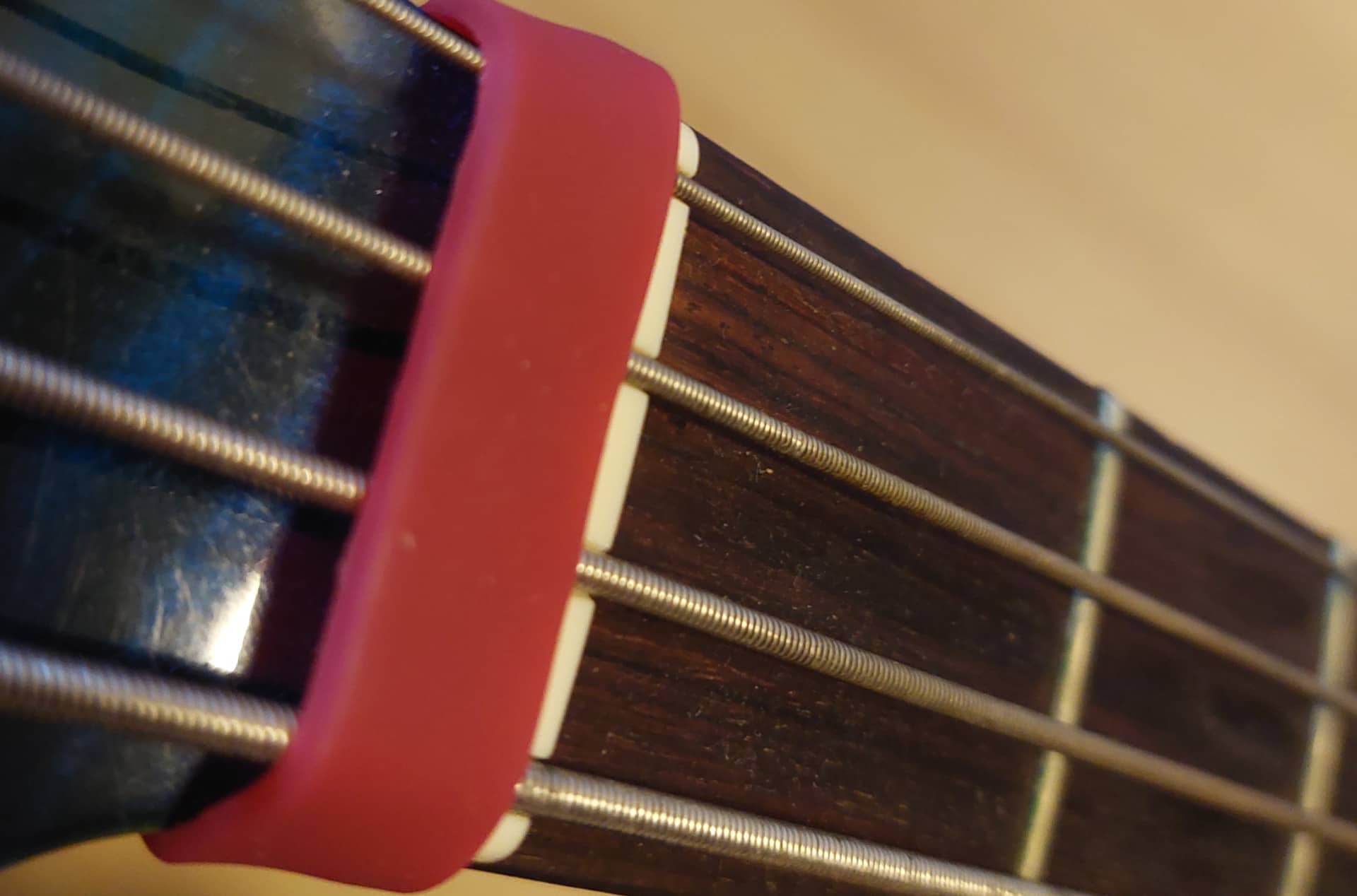You might have noticed that some bassists have a fret wrap at the nut of their bass. In general, this is to help them get a cleaner sound. But if fret wraps are so great, why is not everyone using them, and what is a bass fret wrap for?
The first time I tried using a fret wrap I had already played bass for more than 10 years. Personally, I didn’t feel like it did much to improve my sound. However, I saw how a fret wrap could be helpful to some, and how it could be useful in certain settings.
Therefore, I have written this article to show you what bass fret wraps are all about. I`ll show you what the point of them is, where to get one and how to make your own. I will also clear up some misconceptions so that you know what not to use a fret wrap for.
What is the purpose of a fret wrap?
The purpose of a fret wrap is to produce a cleaner tone and eliminate unwanted sounds when playing the bass. This is done by putting just enough pressure on the strings to cut overtones and to keep accidentally hit strings partially muted.
A Fretwrap will give your open bass strings less room to vibrate by partially muting them. This can either be used for a staccato effect or more commonly, to prevent unwanted strings from ringing out. They also prevent unwanted overtones. This results in a cleaner tone with less unwanted noise.
Some bassists use fret wraps specifically on recordings and for live shows as a safety net. They do so to make sure that unwanted noise is not ruining the overall sound of the band. Others use it specifically for certain songs, either due to the difficulty of it or because the muted sound fits the song.
A big part of learning bass is about teaching yourself how to keep strings muted and play cleanly. Thus, some bassists feel that using a fret wrap is cheating, or that they should be able to play without one.
Related reading: This Is How long You Should Practice Bass Each Day
While having a clean technique is always a plus, there is no reason to think of using a fret wrap as cheating. Playing bass is all about chasing the perfect tone, so if a fret wrap helps you achieve it, there is nothing wrong with using one.
However, a fret wrap neither can nor should substitute proper technique. Thus, you will still need to keep strings muted regardless of whether you play with or without one.
Bass fret wrap DIY
While a DIY fret wrap can be less convenient and less effective than a proper one, they are cheaper.
Ideally, you want something soft for the “head” of the wrap, and something nonsticky to hold it in place. Several common household items can be used to make a DIY bass wrap, such as these ones:
- Hair band – Hair bands can make a great fret wrap on their own. They are really easy to just throw on and off, but they are also severely limited in how much you can adjust them. Thus, it is best to try with hairbands of different sizes to find the best possible fit. If the hair band is too loose you can also attempt to wrap it around the neck twice.
- Foam – A piece of foam does well at damping the strings without having to apply much pressure to it. You will however need a way to keep it attached. For this, I recommend using a rubber band that is on the larger side. Alternatively, you can tape the piece of foam to the neck if you are out of options, but I advise against it.
- Velcro – Velcro is an amazing option for a bass frat wrap. This is because the material is perfect for muting the strings, and sticks to itself. Measure up the velcro around your neck first, and then cut it afterward. It`s best to aim for too long rather than too short the first time you do this. Aim for a width of about 0.8″, or 2cm.
Can you play open bass strings with a Fret wrap?
Depending on where you place a fret wrap, open strings can still be played. In general, open strings can still be played if the fret wrap is placed slightly behind the nut, but they will sound slightly muted when compared to playing without a fret wrap.
With a fret wrap, your open strings are bound to lose some resonance. Depending on the bass, your preferences, and the wrap, this can be a minor inconvenience, or be detrimental to your tone.
Related reading: This is what the tone knobs on your bass does
Some bassists solve this issue by moving the fret wrap when they are playing. For example, they might keep the fret wrap at the first fret while playing a groove at the 5th to 8th fret.
When they switch to playing a bassline that requires an open E, they move the fret wrap towards the headstock to avoid sounding too muted. Thus, while fret wraps make open strings sound muted, this is rarely a big deal.
The issue becomes more prevalent in songs where you do not have the time to switch the position of the fret wrap. This can be detrimental in genres such as metal, where basslines are commonly centered around playing an open string fast and repeatedly.
Fret wrap size chart
What size of fret wrap you need depends on your bass. While basses differ in neck thickness, it is enough to consider how many strings the bass has to get an approximation of what type of fret wrap you need.
Below is a table based on recommendations by Gruvgear. It can be used to pick out what type of fret wrap you need when purchasing one. Alternatively, you can use it as a guideline when making one yourself.
| Fret Wrap Size | Best for | Damper length | Full length with strap |
| Small | 4-string bass guitars | 2.25″-2.5″ (5.7-6.4cm) | 6.5″-6.88″ (16.5-17.5cm) |
| Medium | 5-string bass guitars | 2.38″-2.88″ (6-7.3cm) | 7″-7.88″ (17.8-20cm) |
| Large | 6-string bass guitars | 2.5″-3.4″ (6.4-8.4cm) | 7.25″-8.25″ (18.4-21.1cm) |
| Extra Large | 7 to 12-string bass guitars | 3.63″-4.38″ (9.2-11.1cm) | 9.5″-10.5″ (24.1-26.7cm) |
Conclusion
Bass fret wraps are a great way to clean up your sound or get a less resonant tone. They are helpful for creating a more staccato tone in genres, or individual songs where this is wanted. They can also be used as a safety net to make sure your strings are not ringing out too much.
What I do not recommend is using fret wraps as a “safety wheel” when practicing. While you might sound better with it, this will make it harder to identify mistakes in your playing. Using them for recordings, covers or shows is helpful, but using wraps to substitute proper technique will ultimately hurt your progress as a bassist.
You can either order a set of fret wraps or make your own. Many common household items can be used as a wrap, as long as they can be wrapped around the strings without muting them completely.
If you want a professional fret wrap, I recommend getting one from Gruv Gear. At the time of writing, their fret wraps hold a 4.7-star rating from more than 5000 reviews, and they are popular among both guitarists and bassists.
The button below takes you to a small fret wrap, suited for 4 string basses. You can switch the size to medium for 5-string basses, and large for 6-string basses on the page:

